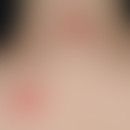Synonym(s)
DefinitionThis section has been translated automatically.
A reverse mosaic is a regressed mutation in a cutaneous mosaic. A clinical-dermatological example of a "reverse mutation" is found in patients with autosomal dominant or recessive forms of epidermolysis bullosa. In this genodermatosis, patches of completely healthy skin are occasionally found in the vicinity of diseased skin.
Molecular biological studies have shown that in these areas a previously mutated allele is later remutated (see below back mutation). The clones thus remutated, in this case "normalized," then produce a normal gene product (Lim YH et al. 2017). The entire progeny is the same as the wild type. The skin shows a normal texture in these back mutated areas.
Note(s)This section has been translated automatically.
It remains to be seen to what extent artificially induced back mutations can be associated with therapeutic hopes.
LiteratureThis section has been translated automatically.
- Lim YH et al (2017) Mosaicism in cutaneous disorders. Annu Rev Genet 51: 123-141
- Lindhurst MJ et al (2011) A mosaic activating mutation in AKT1 associated with the Proteus syndrome. N Engl J Med 365: 611-619



